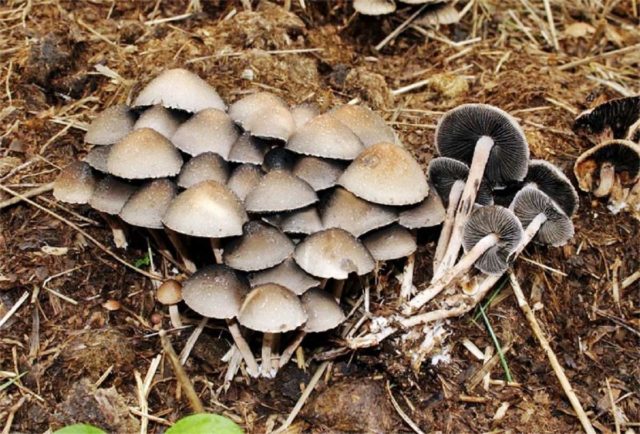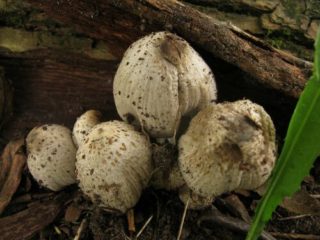Content
The hay dung beetle is a small lamellar mushroom belonging to the class Agaricomycetes, family Psatirelaceae, genus Paneolina. Another name is paneolus. It is classified as a hallucinogen. Appears in May and bears fruit until frost. It grows especially actively in September and October.
Where does the hay dung beetle grow?
The hay dung beetle loves fertile soils. It can be found in pastures, fields, forest edges, lawns, and river valleys. Grows in short grass singly or in small groups. Sometimes the fruiting bodies grow together like honey mushrooms.
What does the hay dung beetle look like?
Paneolus is small in size. The diameter of its cap is from 8 to 25 mm, its height is from 8 to 16 mm.In a young specimen it is semicircular and gradually takes on the shape of a wide cone. When mature, it has the shape of an umbrella or a bell, and is never flat. In wet weather, its surface is soft, grooves are visible. When dry, it becomes covered with scales and becomes torn, this is especially true for old specimens. Color – from yellowish-beige to cinnamon. The dry cap is smooth, light brown; when wet, it darkens and changes color to red-brown.
The leg of the hay dung beetle is smooth, straight, sometimes slightly flat. She is fragile, hollow inside. The surface is smooth, there is no ring. Its height is from 20 to 80 mm, diameter is about 3.5 mm. In dry weather it is light, slightly reddish, in high humidity it is brown. Its color is always lighter than that of the cap (especially at the top and in young specimens); at the base it is brownish.
The plates of the hay dung beetle are wide, frequent, adherent to the stalk. In color they are brownish, pale, spotted, with white edges. After the spores mature and fall out, black specks appear on them.
Is it possible to eat hay dung beetle?
Paneolus hay has a hallucinogenic effect and is inedible. It cannot be eaten.
Properties of hay dung beetle
Hayweed contains the alkaloid psilocybin, which is a psychedelic, mild hallucinogen. Mushroom activity ranges from low to moderate.
If Paneolus satensis enters the intestines, psilocybin is converted to psilocin, which has a weaker effect and causes minor to moderate visual and auditory hallucinations. Its effect begins approximately 20 minutes after consumption. A person can become violent or, conversely, fall into a state of euphoria.Dizziness, tremors of the legs and arms often appear, attacks of fear and paranoia develop.
Similar species
The hay dung beetle has several similar species, which have significant differences.
Paneolus moth. It is classified as inedible, contains psilocybin, and has a moderate hallucinogenic effect. Some sources classify it as poisonous. It grows on rotten grass, cow or horse manure, so it can often be found in pastures and meadows. In most cases it grows in colonies; single specimens are rare. The fruiting season is spring-autumn.
Paneolus moth, despite its similarity to the hay dung beetle, is easy to distinguish by size: it is the largest representative of dung beetles. Another sign is more gray shades in the color of the fruiting body.
The leg is 6-12 cm in length, up to 2-4 cm in diameter, it is hollow and fragile. In a young mushroom you can notice a whitish coating on it. Its color is grayish-brownish and becomes darker when pressed. In some places it contains white fibers in the form of a film.
The diameter of the cap is only 1.5-4 cm. It has a conical shape, slightly blunt. As the mushroom grows, it becomes bell-shaped; at first the edges are bent inward, but when ripe they straighten. On its surface there are white scaly fragments of fibers, the same as on the legs.
The spore plates are frequent, wide, adherent to the stalk, sometimes free.Their color is grayish with marbled spots; older mushrooms are blackened. The spores are black.
In addition to its size, it stands out among related species due to its regular shape and even, straight leg.
- Snow-white dung beetle. Belongs to the inedible species. Grows on horse manure, in wet grass. Fruits from June to September. Its cap is first ovoid, then bell-shaped and finally almost flat. Its color is white, its surface is powdery, washed off by rain, its size is 1-3 cm in diameter. The leg is white, 5-8 cm high, 1-3 mm in diameter. Spore powder and plates are black.
- Paneolus blue – a strong hallucinogen containing psychotropics: psilocybin, psilocin, beocystine, tryptamine, serotonin. Not suitable for human consumption. In some sources it is listed as conditionally edible, requiring careful heat treatment. Found in Central Europe, Primorye, and the Far East. It grows in the tropics and equatorial zones of the Northern and Southern Hemispheres. Fruiting time is June-September. It grows in grass, on manure, and likes to settle in meadows and grazing areas.
In young specimens, the cap is in the form of a hemisphere with the edges turned up; as it grows, it becomes wide, spread-bell-shaped. At first they are light brown, after ripening they become faded, grayish or white, sometimes the yellowish or brownish tint remains. The plates are frequent, in young ones they are grayish, in mature ones they are almost black, covered with spots, with light edges. The pulp is whitish, thin, with a powdery odor.
Conclusion
The hay dung beetle is a small, toxic mushroom with psychotropic effects.It is distributed throughout the world and is outwardly well known to mushroom pickers, for whom it is of no interest, since it cannot be eaten.












